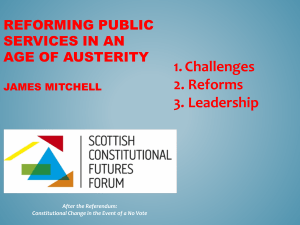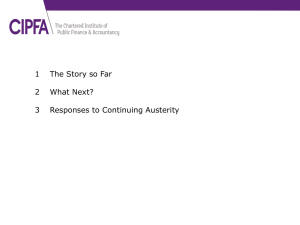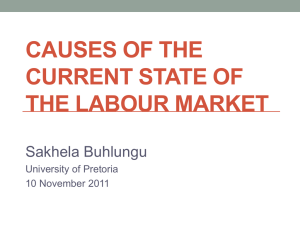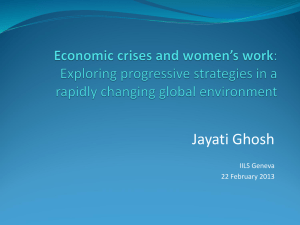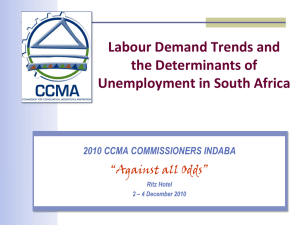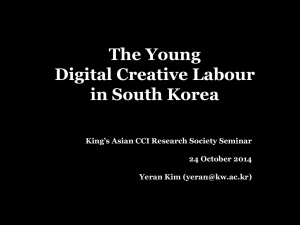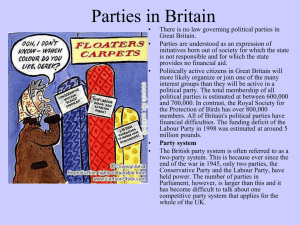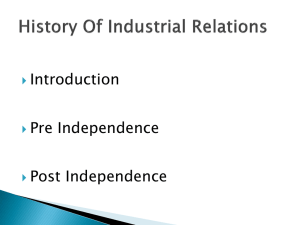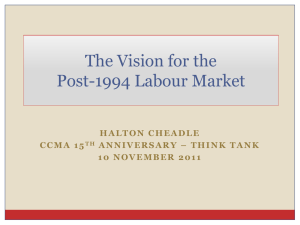Public funding for culture in an age of austerity
advertisement
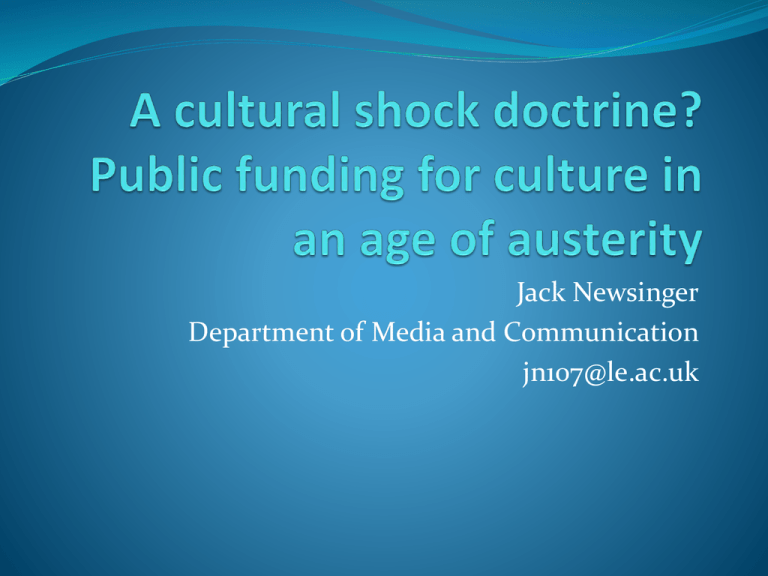
Jack Newsinger Department of Media and Communication jn107@le.ac.uk Structure Cultural policy under New Labour Cultural policy and the Spending Review (2010) Arguments against cutting cultural funding Arguments for cutting cultural funding Public funding for culture in an age of austerity: some (preliminary) conclusions Cultural policy under New Labour Department of National Heritage renamed the Department of Culture, Media and Sport Cultural industries renamed the creative industries The creative industries are “those activities which have their origin in individual creativity, skill and talent and which have a potential for wealth and job creation through the exploitation of intellectual property.” (Creative Industries Task Force, 1998) These are: advertising, architecture, the art and antiques market, crafts, design, designer fashion, film, interactive leisure software, music, the performing arts, publishing, software, television and radio. New institutions: eg UK Film Council, Regional Screen Agencies, Regional Development Agencies. Cultural policy under New Labour ‘Creativity’ as central to the New Labour ‘brand’. Eg “Creativity is at the heart of British culture – a defining feature of our national identity. And today, the force of British creativity is renowned throughout the world [...] In the coming years, the creative industries will be important not only for our national prosperity but for Britain’s ability to put culture and creativity at the centre of our national life.” Gordon Brown (2008) Cultural policy under New Labour DCMS announces the largest increase in Arts Council Funding ever in 2000 – 60% by 2003-2004. Creative industries seen as central to the economy: 46 per cent growth in employment terms and 136 per cent in output by 2015; In 2004 the creative industries accounted for eight per cent of UK Gross Value Added compared to four per cent in 1997; Five per cent growth per annum between 1997 and 2004 compared with three per cent for the economy as a whole; Employ 1.8 million people in the UK; Creative industries exports contributed £13bn to the balance of trade, or four per cent of exports. (Holden, 2007) Cultural policy under New Labour A ‘Golden Age’? (Christopher Frayling) Actual economic importance overstated? Instrumental philistines? Two key features: 1) Small-to-medium sized enterprises (SMEs) as the symbolic driving force of the creative industries Key drivers of other policy objectives: social inclusion, diversity, regeneration 2) The ‘market for support’ in cultural funding Cultural policy under New Labour: some responses Creativity doctrine (Schlesinger, 2007) Depoliticised (Vickery, 2007) Institutionalised individualisation (McGuigan, 2010) ‘Bullshit’ (Befiore, 2009) Information society policy (Garnham, 2005) Culture and media policy as public policy (Hesmondhalgh, 2005) Cultural policy and the Spending Review DCMS budget cut by 24% Museums and Galleries 15% British Film Institute 15% Arts Council of England 30% Creative Partnerships initiative closed Creativity, Culture and Education closed 15% cut to Regularly Funded Organisations UK Film Council closed (the ‘bonfire of the quangos’) Regional Screen Agencies reduced from nine to three, renamed Creative England Regional Development Agencies closed Responses to the cuts “Not one commercial show is made without talent fostered in the subsidised sector. The dominance of British talent in musicals around the world, from Mamma Mia! to the Lloyd Webbers, have all been dependent on people who learned their craft writing, directing, designing and acting in tiny theatres for less than subsistence wages. Yet in VAT on the West End alone the government makes more than the entire subsidy to theatre. It is just economically illiterate not to understand that theatre effectively pays for itself many, many times over.” Lee Hall, 2010 Mark Wallinger Responses to the cuts http://www.lost-arts.org/ Musicians' Union Public and Commercial Services Union (PCS) BECTU Unite National Union of Journalists (NUJ) Equity Prospect Writers' Guild of Great Britain Arts Council cut map: http://www.guardian.co.uk/news/datablog/interactive/2011 /mar/30/arts-council-cuts-map Responses to the cuts 'An important message about the arts' - an animated video by artist David Shrigley http://www.youtube.com/watch?v=T6rYDaORe3k&fea ture=player_embedded Responses to the cuts “over-indulged quangos” who had wasted subsidy on a “multicultural nomenklatura of senior lieutenants” “If we are going to blame anyone, we should perhaps look at the Arts Council and its obsession with political correctness.” The cuts are “a spring prune of the kind private companies undergo every few years”. “The great writers and painters and composers of past centuries had to do without an Arts Council. Did Shakespeare have to apply to an Alan Davey figure for funds? He did not. Did John Donne have to go on arts awareness seminars in the NorthEast to show his devotion to ‘access’? He did not. The great creative talents of past centuries relied on the occasional patron and on naked commercial appeal.” “today’s announcements will be part of a wider cultural battle that is far too important to ignore.” Quentin Letts, 2011 Responses to the cuts “the labyrinthine, pathologically-left-leaning quangocracy which generously bestows public money more in proportion to political correctness than artistic merit.” “there is undoubtedly something in the observation that state funding has produced a bland, monochrome or monotonous, almost Stalinist uniformity in the national artistic expression (where are the ‘right-wing’ plays, playwrights, poets or theatre directors?). In a centralised bureaucracy, cultural diversity is diminished and creativity atrophies because it is sustained by the state instead of being sympathetically euthanised by the market.” Adrian Hilton, 2011 Cultural bureaucracy Hostility to the cultural management mechanisms associated with New Labour The ‘market for support’ Central government increasingly determined how money was spent through targeted schemes and predetermined policy objectives (Galloway, 2004). “While it was the Conservative government of the 1980s that first introduced the mantra ‘culture should serve the economy’, since 1997 New Labour has added a whole list of priorities – still on the basis of instrumental outcome. The DCMS is becoming increasingly ‘hands on’” Frayling quoted in Hylton, 2007 It’s political correctness gone mad “We will act to eliminate individual and institutional racism, meet the needs of our clients and staff, comply with our statutory responsibilities and make race equality a core issue in all that we do, across all programmes and activities.” (Arts Council Race Equality Scheme, 2004: 6) “Public money will no longer be given to arts organisations simply because they hire a high proportion of women or ethnic minorities”. Jeremy Hunt MP, 2010 It’s political correctness gone mad “the received wisdom is that over the last decade government has placed greater emphasis on instrumental outcomes. While there have been new, targeted initiatives in areas such as education, there is little evidence that any prioritisation of social or economic objectives has had any substantial impact on the decisions that have been made about mainstream arts funding, or indeed on how artists and arts organisations go about their work.” (Bunting et al, quoted in Knell and Taylor, 2011: 13) A genuine policy debate about instrumentalism, eg: “Since the late 1970s, cultural diversity initiatives within the visual arts sector have arguably exacerbated rather than confronted exclusionary pathologies of the art world.” (Hylton, 2007: 131) The role of the private sector in culture Perception of the relative wastefulness of the public sector goes back to the 1970s. Various initiatives designed to encourage commercial values and practices in the cultural sector, ie Business Sponsorship Incentive Scheme The market for support Fundamentally an argument about the size and role of the state. A mixed cultural economy or a free market? Coalition cultural policy Not much actual cultural policy from the coalition government so far. ‘The Future of the Arts with a Conservative Government’ 2010 Arts Manifesto A commitment to the mixed economy Endowments to enable philanthropy Increased match funding Cutting administrative costs Remove targets Coalition cultural policy "People have had an assumption about Conservative governments partly because of some of the things that happened in the 1980s and partly because of the tone of some of the debate around the arts in the 1980s, which appeared to say public spending on the arts was something you might progressively want to reduce, which isn't where the modern Conservative party stands. We recognise the critical importance of public funding.” (Hunt, quoted in Higgins, 2010) Public funding for culture in an age of austerity: some conclusions Coalition cultural policy has been based upon large cuts to public funding for culture in common with other areas of the public sector Not major restructuring Cuts to cultural funding are part of a wider argument about the size of the state Attacks on progressive cultural policy and left-wing cultural intelligentsia Disproportionately effect on regional, heavily subsidised, less commercial organisations
